When you buy a product through our links below, we may earn money from our affiliate partners to help support the site. However, this does not affect our evaluation or recommendation of each product. See our list of partners & how we get paid here. You can also learn our process for reviewing tennis gear here.
The best tennis racquet for intermediate players is the Yonex Ezone 100. This racquet is arm-friendly with a good combination of power and control that intermediate players need to improve. I recommend the Solinco Blackout if you need a more powerful racquet. For a more control-oriented racquet, choose the Prince ATS Textreme Tour 100P.
Below you will find reviews of the best tennis racquets for intermediate players. I also created a buyer’s guide to help you find the perfect racquet for your goals and game style.
With decades of experience playing and coaching tennis, as well as a certified master racquet technician on our team, our expert reviews are trusted by 10,000’s of tennis players worldwide every month. We’ve researched and play-tested intermediate tennis racquets from all the best brands, analyzing each racquet based on its specifications, power, spin, and more.
Here is a quick summary of what you should know about intermediate racquets.
- Tennis racquets for intermediate players have a slightly larger head size and weigh less than advanced racquets. Look for a racquet around 100-105 square inches and 11 ounces.
- Intermediate racquets are the same length as advanced racquets, usually 27 inches.
- Intermediate players should choose a racquet that helps their game style. Don’t choose a powerful racquet if you need help with control, for example.
Leave a comment at the bottom of this page for more personalized racquet recommendations from one of our experts.
List of the Best Intermediate Tennis Racquets
The table below shows our picks for the 9 best tennis racquets for intermediate players by category. We reviewed each racquet in more detail below.
Click the links below to order your racquet from Tennis Warehouse.
| Category | Racquet |
|---|---|
| Best Overall Intermediate Racquet | Yonex Ezone 100 Jump to Review |
| Best Intermediate Racquet for Power | Solinco Blackout Jump to Review |
| Best Intermediate Racquet for Control | Prince ATS Textreme Tour 100P Jump to Review |
| Best Intermediate Racquet for Comfort | Volkl Vostra V8 Jump to Review |
| Best Extended Length Racquet for Intermediate Players | Wilson Blade 104 Jump to Review |
| Great for Spin & Easy to Handle (endorsed by Coco Gauff) | Head Boom MP Jump to Review |
| Combination of Power & Spin (endorsed by Rafael Nadal) | Babolat Pure Aero Jump to Review |
| Great for Transitioning to a Control Racquet | Yonex Percept 100D Jump to Review |
| Best Lightweight Intermediate Racquet | Head Extreme Team Jump to Review |
Reviews of the Top 9 Intermediate Tennis Racquets
Next, we’ll dive into the specifics of each racquet, reviewing what makes each one a good choice for specific types of intermediate-level tennis players.
At the bottom of each review below you will see a relative price on a scale from 1 to 3 dollar signs, and our recommended USTA Rating level for the racquets based on our research. Some racquets are good for all skill levels while others are for more specific types of players.
3 Steps to Find the Perfect Tennis Racquet for Your Game
Free checklist with 27 racquet recommendations
#1 – Yonex Ezone 100: Best Overall
Yonex is a fast-growing tennis racquet brand that many professional tennis players are now using. The Yonex Ezone 100 is used by several professional women’s tennis players and is a well-balanced racquet for most skill levels.
The 100-square-inch frame combined with the 16×19 string pattern makes it easy to control shots from the baseline with spin. Yonex tennis racquets are known for their unique frame design which creates more comfort than most other racquets. Also, the frame’s width and weight of 11.2 ounces, provide extra power for players who are just past the beginner stage.
This racquet is great for intermediate to advanced-level players who need extra spin and power. It is not a great tennis racquet for beginners who don’t make contact with the center of the racquet consistently or a serve and volley player.
Read our full Yonex Ezone Review.
- Specs: 100 sq. inch head size | 11.2 oz.
- Price: $$$
- USTA Rating: 3.0 & up
Pros
- Great power on groundstrokes
- Excellent topspin & comfort in the sweet spot
- Lightweight with good mobility
- Added power & spin on serves
- Consistent performance from the baseline
Cons
- High-end pricing for recreational intermediate players
- Not great for volleys at the net
#2 – Solinco Blackout: Best for Power
Solinco is relatively new to the racquet game, but that hasn’t prevented them from starting out with some fantastic racquets. The Blackout racquets are very powerful with surprisingly good feel.
The 71-RA stiffness provides great stability and power. This usually leads to a harsh response to your arm, but the Blackout is unexpectedly comfortable. It also has fantastic spin potential, great for the modern baseline player.
At the net, the Solinco Blackout performs great for such a powerful racquet. It could benefit from a little extra control at the net, but it makes up for that with its great stability.
Read our full Solinco Blackout Review.
- Specs: 100 sq. inch head size | 11.3 oz.
- Price: $$$
- USTA Rating: Any skill level
Pros
- Great for any level
- Fantastic power on groundstrokes & serves
- Excellent spin for players learning topspin
- Great feel with a generous sweet spot
- Good maneuverability
Cons
- Lacks some stability & control at net
#3 – Prince ATS Textreme Tour 100P: Best for Control
Prince is one of the most trusted brands in tennis, and their ATS Textreme Tour 100P is a great option for stronger players who can create power. This is one of the most control-oriented of all the Prince tennis racquets.
This tennis racquet’s 100 sq. inch head size gives it a generous sweet spot for a wide range of skill levels. The advanced technology Prince has put into this racquet, along with the frame design, allows you to create decent power. However, the area that this racquet performs best is its feel and control. The tight string pattern and flexible frame allow players to take big swings on groundstrokes and still control the tennis ball with precision.
At 11.4 ounces, it has good stability as well but isn’t too difficult to handle. Any physically strong adult who wants a comfortable racquet with maximum control will love the Prince ATS Textreme Tour 100P.
Read our full Prince Tour Review.
- Specs: 100 sq. inch head size | 11.4 oz.
- Price: $$
- USTA Rating: 3.5 & up
Pros
- Good control & spin for groundstrokes & serve
- Great feel & easy to swing
- Decent maneuverability for its weight
- Allows you to improve fast & swing big
- Solid option for advanced players as well
Cons
- A bit heavy for beginners & low-level intermediate players
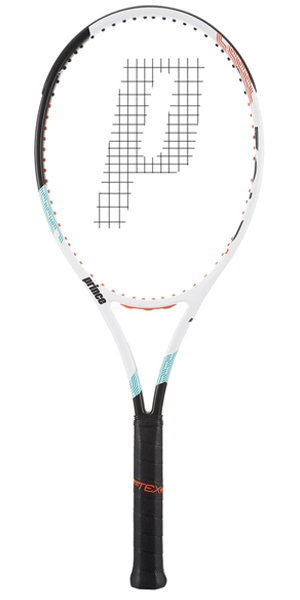

#4 – Volkl Vostra V8: Best for Comfort
Volkl is known for making some of the most arm-friendly tennis racquets, and the Vostra V8 continues that tradition. Their dampening technologies filter out harsh vibrations better than more popular racquet brands.
The Vostra V8 features an open 16×18 string pattern aiding the comfort while also providing exceptional spin potential and power. This racquet has great maneuverability from both the baseline and at the net. While many Volkl racquets suffer from a lack of feel on volleys, this racquet is one of the best I have tried from Volkl in that regard.
The only downside is a lack of control, particularly from the baseline. If you hit flatter groundstrokes, you will want to try a racquet with a more dense string pattern.
Read our full Volkl Vostra V8 Review.
- Specs: 100 sq. inch head size | 11.2 oz.
- Price: $$$
- USTA Rating: 3.0 & up
Pros
- Great power on groundstrokes
- Excellent topspin & comfort in the sweet spot
- Lightweight with good mobility
- Added power & spin on serves
- Consistent performance from the baseline
Cons
- High-end pricing for recreational intermediate players
- Not great for volleys at the net
#5 – Wilson Blade 104: Best Extended Length Racquet
The Wilson Blade has long been one of the top-selling racquets for both men and women, and the Wilson Blade 104 continues that tradition. This racquet has a 104-inch head, providing extra stability and forgiveness. It also is 27.5 inches long, a half inch longer than the standard racquet, giving this racquet ample power for those who want to hit big groundstrokes.
This racquet also comes with a standard 16×19 string pattern, adding plenty of spin to keep the power under control. While this racquet has a reasonable 10.8 oz weight, the extra length of the racquet does make this racquet a little more difficult to maneuver quickly.
The Blade 104 is a great racquet for intermediate players who want the extra power from an extended length racquet and don’t mind sacrificing maneuverability.
Read our full Wilson Blade Review.
- Specs: 104 sq. inch head size | 10.8 oz.
- Price: $$$
- USTA Rating: 3.5 & upo
Pros
- Very powerful
- Extremely stable
- Good spin potential
- Great against hard-hitting opponents
Cons
- Not for beginners
- Not very maneuverable

#6 – Head Boom MP: Great for Spin & Easy to Handle
This is the best intermediate racquet for players looking for a user-friendly racquet that provides lots of power. A version of this racquet used by Coco Gauff.
The 100-square-inch frame gives it an excellent sweet spot. Combined with the 318 swing weight, this racquet gives excellent ball feedback from the baseline or at the net. However, it excels for singles players looking to grind from deep in the court. You’ll be able to control the point and go for the lines better than most other racquets this size, making it one of the best tennis racquets for women.
This tennis racquet is not a great racquet for advanced doubles players who like to come to the net because it lacks some stability. But for most skill levels, it’s a great pick. Read our other Head tennis racquet reviews if you are partial to the Head brand.
Read our full Head Boom Review.
- Specs: 100 sq. inch head size | 11.0 oz.
- Price: $$$
- USTA Rating: 3.0 & up
Pros
- Very playable for different styles
- Easy access to power and spin
- Big sweet spot
- Very comfortable racquet
- Great for learning topspin
- Allows beginners & intermediates to improve
Cons
- It lacks stability, especially around the net
- This version is not great for highly advanced players
Stop paying full price for tennis gear! Get deals on shoes, racquets & more up to 70% off.
#7 – Babolat Pure Aero: Maximum Power & Spin
The Babolat Pure Aero, used by Rafael Nadal, is the top-rated racquet for spin on the market. If you have a fast, big swing and like to hit a lot of topspin from the baseline, this racquet is for you.
The frame is 100 square inches for a bigger hitting area and is also built with aerodynamic technology to cut through the air. This will help you generate more racquet head speed, and therefore spin on the ball. The recommended string tension is in the low 50’s so you can create tons of power on your serve too.
For intermediate players, this is a great option if you’re playing singles and want to develop your ability to control your shots and the point with topspin. For more power or control, you can read more Babolat tennis racquet reviews. This racquet isn’t ideal for fast-paced doubles or a player seeking more control. Check out the Pure Aero Lite if you want a racquet that is even easier to swing.
Read our full Babolat Pure Aero Review.
- Specs: 100 sq. inch head size | 11.2 oz.
- Price: $$$
- USTA Rating: Any skill level
Pros
- Best racquet for power & spin
- Heavy groundstrokes & powerful serve
- Large sweet spot gives it good feel
- Good for all skill levels
Cons
- Not great for control
- Not ideal for doubles players
#8 – Yonex Percept 100D: Great for Transitioning to a Control Racquet
The Yonex Percept 100D is a great addition to the Percept line of racquets (formerly called Vcore Pro) for the 2023 release. It has unique characteristics that make it great for those wanting to try out a more control-oriented racquet that still provides some power.
This frame has added stiffness in the hoop along with a 100 square-inch head creating great stability and forgiveness. It also provides decent power but adds a rare 18×19 string pattern to maintain excellent control.
Intermediate players, particularly intermediate doubles players, will also love the maneuverability this racquet provides at the net. The 18-main string pattern gives a lower launch angle that takes a little adjustment, but it works great to keep the ball lower over the net to prevent your opponents from poaching when playing doubles.
- Specs: 100 sq. inch head size | 11.3 oz.
- Price: $$$
- USTA Rating: 3.5 & up
Pros
- Very forgiving
- Great combination of control and power
- Allows for intermediate players to grow
- Especially great for doubles
- Maneuverable
Cons
- Lower launch angle requires adjustment from most other racquets
#9 – Head Extreme Team: Best Lightweight Racquet
The Extreme has become a popular racquet among intermediate players over the past decade. Endorsed by ATP top 10 player, Matteo Berrettini, the Head Extreme offers excellent power and spin.
The 105-square-inch frame of the Extreme Team is very forgiving, perfect for intermediate players. The wide frame gives it extra power, and the open string pattern allows for added spin. This racquet has everything you want for hitting big groundstrokes from the baseline. At 9.8 oz strung, it is very lightweight for players looking for a racquet that is easy to swing.
It lacks some control and stability for higher-level players, especially at the net. However, intermediate players will have no problems defending and attacking with this racquet.
Read our full Head Extreme Review.
- Specs: 105 sq. inch head size | 11.2 oz.
- Price: $$$
- USTA Rating: Up to 4.0
Pros
- Fantastic power on groundstrokes & serves
- Excellent spin for players learning topspin
- Great feel with a generous sweet spot
- Very easy to swing
Cons
- Lacks some stability & control against pace
Buyer’s Guide: How to Choose a Tennis Racquet for Intermediate Players
We have a complete guide on how to choose a tennis racquet, so if you’re transitioning into tennis, or just haven’t learned much about racquets before, we recommend starting there.
The three primary factors that should determine the right tennis racquet for intermediate players are head size, weight, and string pattern.
Here are a few questions to ask to help you choose the right racquet.
- What is your game style? Do you like to run around on the baseline, getting every ball back? Or do you prefer to play more offensively and attack the net?
- Do you need help with power or control?
- What are your tennis goals? If you’re trying to learn topspin, for example, you’ll need a spin-friendly racquet.
- What’s your budget? Serious players may want to spend more money than a non-competitive recreational player.
Lastly, once you’ve picked out your racquet, you need to pick out a set of strings to go with your new racquet.
Are You Ready for an Intermediate Racquet?
First, decide which of the below describes you best to help narrow your search for a new racquet.
Beginner Tennis Players
I’m new to tennis and don’t have much, or any, experience. I play very rarely, but I’m thinking about getting more serious, so I’m looking for a racquet to practice more. I may even start taking lessons too.
If this is you, see our picks for the best beginner tennis racquets.
Intermediate Level Players
I used to play recreationally, but it’s been a while since I played consistently. Or I started playing in the last year or two, but I want to try and take my game to the next level. I can play points and matches and may have a more defined style, such as attacking the net or outlasting my opponents with consistency. I still struggle to hit with power and spin.
If this is you, you’re in the right place!
Advanced Level Players
I play regularly and can hit groundstrokes and serve with spin, power, and direction. This would be 4.0 and higher on the USTA scale.
If this describes you, then check out the best tennis racquets for advanced players.
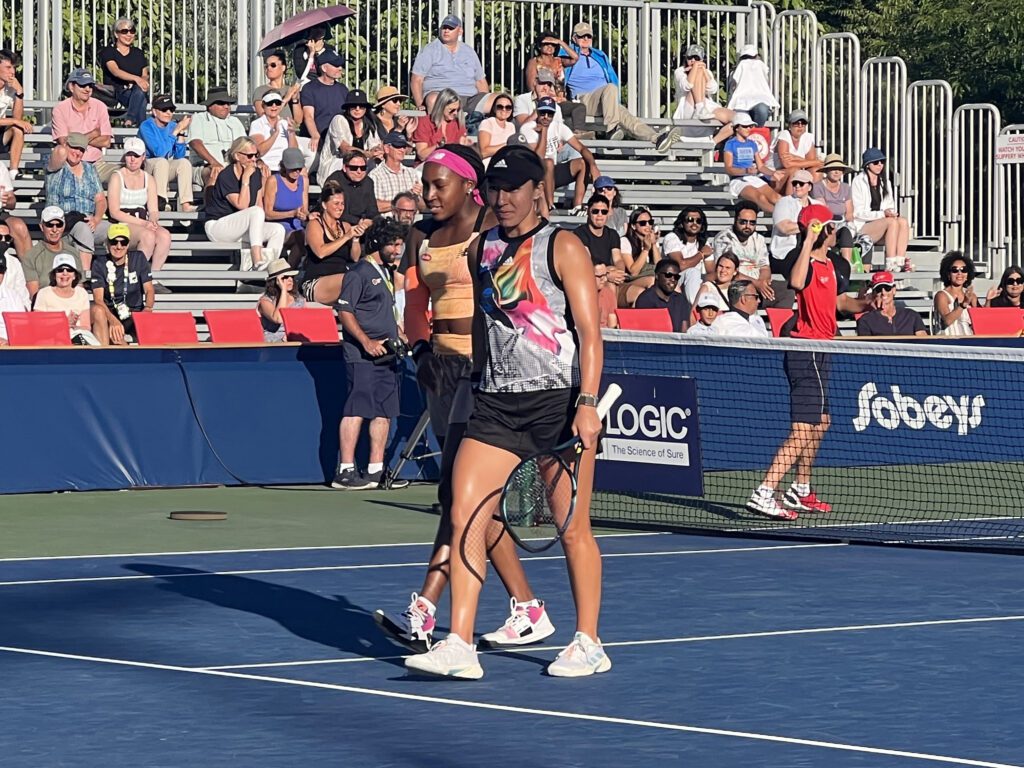
What Makes a Racquet Good for Intermediate Players?
The table below provides a general guideline to follow. Many metrics can be used to describe a racquet, but these are the most important things to consider.
| Racquet Specifications | Beginner Players Only | Intermediate & Some Beginner | Advanced & Some Intermediate |
|---|---|---|---|
| Head Size (sq. inches) | 107 – 115 | 100 – 110 | 95 – 100 |
| Weight (strung) | Under 11 Ounces | 10.1 – 11.5 Ounces | Over 11 Ounces |
| Price | Under $150 | $100 & up | $150 & up |
| Power vs Control | More Power | Balanced Racquet | More Control |
Intermediate tennis players need a racquet that has a big enough head size to give them power and stability, but a small enough head size to maintain control. They also need a racquet that is maneuverable enough to swing without too much effort, but heavy enough to add forgiveness when they miss the sweet spot on their racquet.

Note on Racquet Length: Nearly all adult tennis racquets are 27 inches in length. They can go up to 28 inches, but this shouldn’t be a huge factor in your buying decision.
Choosing a Racquet Head Size for Intermediate Players
Intermediate players should use a racquet roughly 100-110 square inches.
- Larger head sizes will have greater power and forgiveness on off-center shots.
- Smaller head sizes provide greater maneuverability and control.
Intermediate players with slower swings or who struggle to consistently hit the sweet spot should err on the larger side, while intermediate players who are swinging faster or have the hand-eye coordination to hit the sweet spot consistently will want a racquet with smaller size.
Choosing the Right Weight for Your Racquet
The best racquets for intermediate players weigh between 10.1 and 11.5 ounces.
A lighter racquet will be easier to maneuver. If you’re not swinging very fast, you might want a light racquet that is easier to swing.
- Best Lightweight Intermediate Racquet: Head Extreme Team
On the other hand, heavier racquets will provide a little extra power and stability. The stability will help you maintain control on off-center shots, perfect for players who are physically strong and beginning to swing faster.
What String Pattern Should I Look For in a Racquet?
One aspect of tennis racquets that you should keep in mind is the string pattern. The string pattern refers to how many times the string goes up/down and left/right on the racquet.
The most common string pattern and the one most intermediate players should use, is 16×19.
A racquet with fewer strings is considered more “open” and helps promote power and spin. Racquets with more strings are considered “closed” and increase control and feel.
- Best Intermediate Racquet for Spin: Head Boom MP
- Best Intermediate Racquet for Control: Prince ATS Textreme Tour 100P
The Head Boom MP has a 16×19 string pattern, making it more open and great for developing topspin. The Prince ATS Textreme Tour, on the other hand, has an 18×20 string pattern, making it more closed. While it will have less spin potential, it will offer greater control and feel.
What is Your Game Style? Do You Stay at the Baseline or Attack the Net?
Another way to help narrow your racquet search is to consider your style of play.
If you like to stay at the baseline hitting groundstrokes, a racquet that is more powerful and spin-friendly will suit you best. Players who attack the net will prefer a racquet that is more maneuverable with greater control and feel.
- Best Intermediate Racquet for Groundstrokes: Babolat Pure Aero
- Best Intermediate Racquet for Volleys: Yonex Percept 100D
Stop paying full price for tennis gear! Get deals on shoes, racquets & more up to 70% off.
What Strings Belong in My Racquet as an Intermediate Player?
Intermediate players, like beginners, don’t need to worry too much about their tennis string type or tension yet.
If you have any history of arm injuries, or you need more power, choose a multifilament string. Otherwise, an inexpensive synthetic gut string will be the best tennis string for you.
Intermediate players should stay away from polyester (and co-polyester) strings until they reach an advanced level.
As for string tension, racquets generally have a 10 or 15-pound range (i.e. 50-60 lbs) that they recommend. If you aren’t sure, just start in the middle. If you find your shots landing short, string looser for more power. If you keep hitting long, consider stringing tighter for more control.
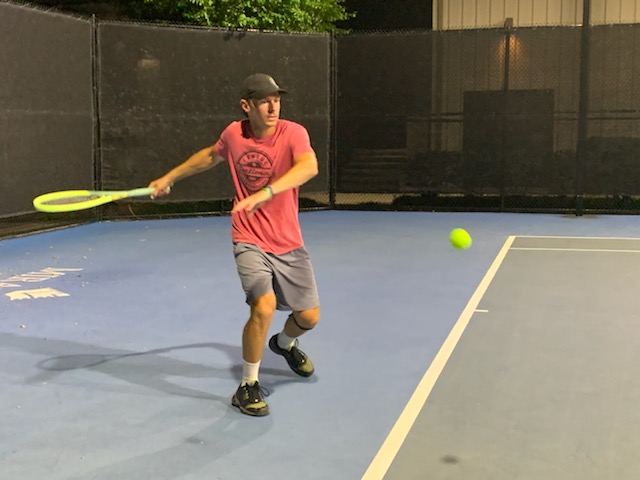
What are Your Tennis Goals? Do You Want to Become an Advanced Player?
You’ll need a different racquet depending on your goals. If you plan to start taking tennis more seriously, playing leagues and tournaments, then you’ll need to buy a racquet that allows you to improve to a more advanced skill level. Most racquets on our list will allow you to do that. You may also consider purchasing a tennis ball machine to save on lessons.
As you keep playing more tennis you may want to read more tennis gear reviews so you can get better on-court gear like the right tennis strings, tennis bags to carry your racquets, and shoes for tennis.
If, however, you just want to hit recreationally for fun and to stay in shape, then you can work with a smaller budget and buy a racquet that isn’t quite as advanced.
Conclusion: Our Pick for Best Intermediate Level Racquet
Intermediate tennis players have literally hundreds of racquets to choose from. Depending on your playing style and goals, you will need a specific racquet.
However, the best tennis racquet for most intermediate players is the Yonex Ezone 100.
The Ezone 100 works great for beginners, intermediate, and advanced players, so you won’t have to switch racquets as you improve. Yonex has made the perfect “player’s racquet” with a great combination of control, comfort, and feel. This racquet provides mobility for doubles as well as a combination of power and spin for groundstrokes in singles.
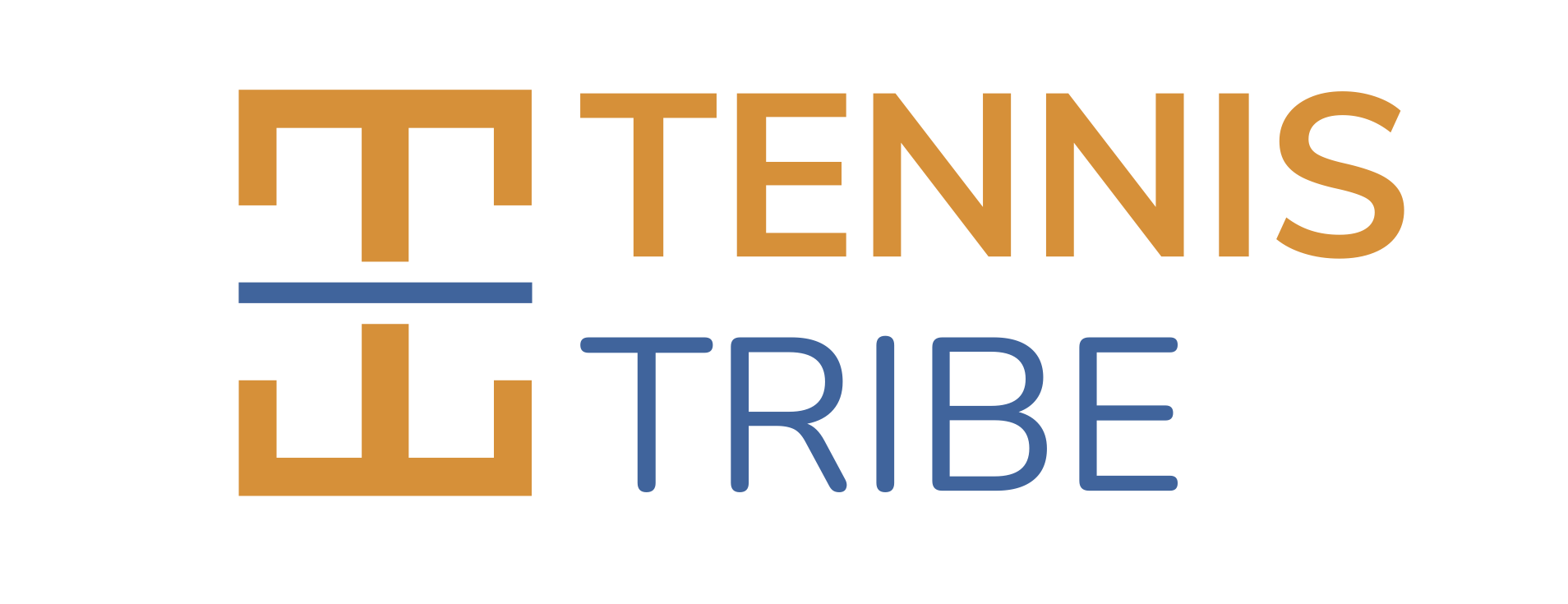
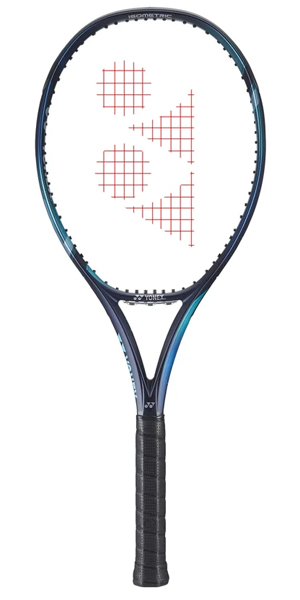


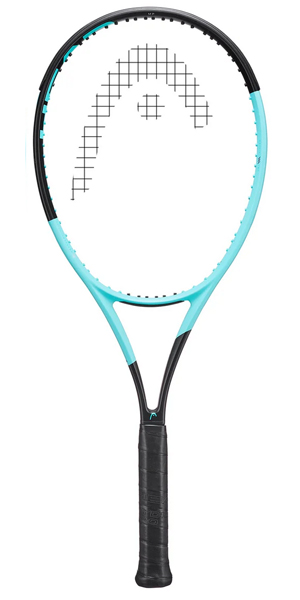
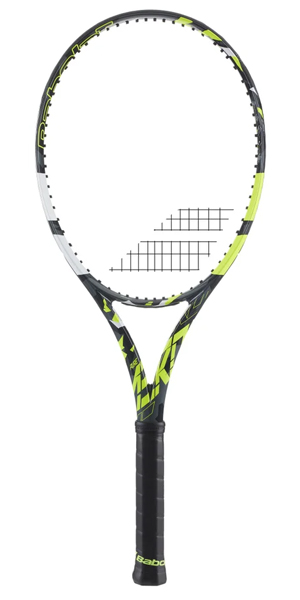
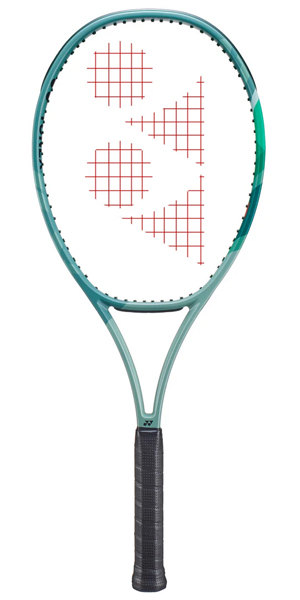

I found your racquet buyer’s guide very informative. I’m interested in your thoughts on my current racquet, the Volkl Vostra V4 (strung with gut, but I will likely look for a spinier multi)
I am a 70 year old USTA 3.0 male that returned to tennis 3 years ago. The Volkl is maybe a bit too light and a tad un stable at the net. I play mostly doubles. Should I look for an expert customizer to add at little more swing weight or try something like a Clash, Boom, Extreme or Ezone.
My arm feels fine now but I have had issues in the past.
Hi John, I’m glad you found the guide helpful! The Vostra V4 is a great racquet and seems like it would be a good fit for you. Rather than taking your racquet to an expert customizer, I’d recommend looking at these pre-measured strips of lead tape or tungsten tape. Try putting one on each side of the racquet (at 3 and 9) to add a little stability.
As for strings, if you’re looking for a spin-friendly multi, I would try Head Velocity MLT. It’s very soft to help prevent arm injuries and is more spin-friendly than most multis I have tried.
Thank you Nate…I will try it!